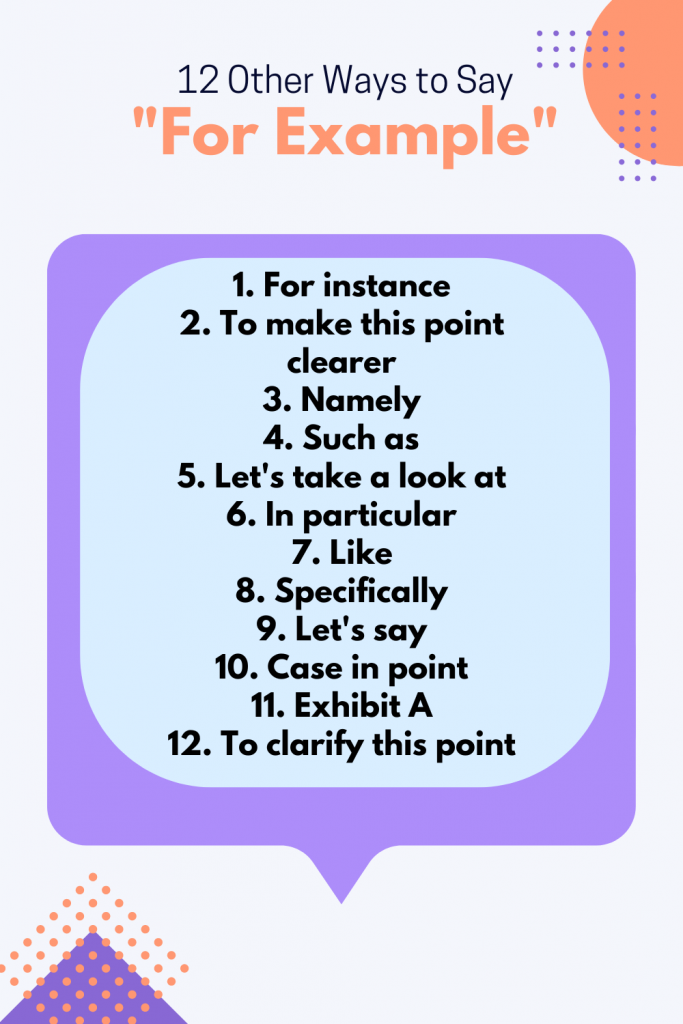When we want to give an example that shows what we’re talking about, most people use the phrase “for example”. It does a good job of connecting our big ideas to the small things of real life. But there are actually a bunch of other ways to say the expression “for example” that can sound more interesting or fit different situations better.
It’s helpful to lay out some alternatives so we’ve got more tools in our back pocket when we want to toss out an example. Each one adds its own flavor and connects ideas to concrete stuff in its own way and expanding how we transition to examples makes our points clearer, our arguments more convincing and just generally keeps things from getting dull cause we overuse the same phrase over and over.
Other Ways to Say “For Example”
1. For instance
Example: “For instance let’s consider the case of the Endangered Species Act.”
Meaning: This serves as an example to better explain or demonstrate a point.
Usage: It is often used in professional contexts where clarity and precision are important.
2. To make this point clearer
Example: “To make this point clearer let’s take a look, at market trends.”
Meaning: This helps to provide an example that makes something more understandable.
Usage: It can be used in contexts from business discussions to conversations.
3. Namely
Example: “Several factors contribute to this change, namely increased awareness and new regulations.”
Meaning: The word “namely” is used here to introduce examples or details after making a statement.
Usage: This is commonly seen in writing and speaking in academic and technical fields.
4. Such as
Example: “Various types of foods, such as berries and nuts contain levels of antioxidants.”
Meaning: For instance, there is a range of food options that are known for their properties. Berries and nuts are a couple of examples within this category.
Usage: This expression is commonly used in forms of communication, such as written articles, conversations, formal presentations, or casual discussions. It serves to provide examples that exemplify a concept.
5. Let’s take a look at
“Let’s take a look at the advancements in agriculture as an illustration.”
Meaning: To better understand the topic at hand it’s worth examining the progress made in technology in times.
Usage: This phrase is often employed to highlight an aspect or development, within a context. It aims to engage the audience by drawing their attention towards an area that holds importance or interest within the discussion.
6. In particular
Example: “In particular, the study concentrates on examining the impacts of climate change in regions.”
Meaning; This phrase is used to highlight an aspect within a context emphasizing its importance or relevance, in the given discussion.
Usage; It is commonly employed in research, policy debates, and any situation where it is necessary to differentiate and emphasize an area within a broader category.
7. Like
Example: “There are challenges associated with planning, like traffic congestion and pollution.”
Meaning: “Like” is used to provide an example or draw comparisons that make the information more relatable and comprehensible. It can introduce examples that represent a group or category.
Usage: This term is suitable for conversations, casual presentations, and conversational writing. It is often used in social media content, interviews, and when addressing an audience.
8. Specifically
Example: “The policy has implications for groups, specifically students and young professionals.”
Meaning: “Specifically” indicates a subset or precise aspect, within a topic enhancing specificity and focus. It assists in breaking down topics into easier-to-understand components by pinpointing important areas or categories.
Usage: Frequently observed during gatherings, educational presentations, and, in the context of technical conversations. Additionally, it is utilized in writing to emphasize details or statistics, within a broader article.
9. Let’s say
Example: “Let’s say you’re planning a trip to Europe; budgeting is essential.”
Meaning: “Let’s say” serves as an invitation to explore a scenario, whether fictional in order to better understand a concept or situation. It encourages the audience to visualize and relate to an idea by creating a mental image.
Usage: This phrase is particularly useful, in settings. When explaining complex topics. Whether you’re leading a workshop offering advice to a friend or brainstorming in a meeting using “let’s say” sets the stage for a story where everyone involved becomes part of the narrative.
10. Case in point
Example: “Case in point: the company’s successful turnaround strategy.”
Meaning: “Case in point” acts as a flourish that supports your argument with real-world evidence. It conveys the message that you have proof to back up your claims.
Usage: This phrase works well in debates, persuasive speeches, or analytical discussions where presenting examples strengthens your position. Whenever you want to provide evidence to support a statement the phrase “case in point” is perfect. It signifies that you have an example that solidifies your argument.
11. Exhibit A
Example: “Exhibit A in this argument is the rapid growth of the tech industry.”
Meaning: “Exhibit A” is like the sibling of “case in point.” It’s like pulling a rabbit out of a hat during a conversation. You use it to present an example with a touch of drama or humor. It’s your way of saying, “Look no further here’s the perfect illustration of what I’m talking about.”
Usage: It works well in settings. When you want to add some humor to your speech. Whether you’re engaged in a discussion with friends giving a hearted presentation or writing a blog post that needs some fun elements, “Exhibit A” brings entertainment while making your point clear.
12. To clarify this point
Example: “To clarify this point let’s examine the market trends.”
Meaning: This serves as an example to make something more understandable.
Usage: It is a phrase that can be used in contexts ranging from business discussions to casual conversations.

When to Use Different Alternatives of “For Example”
Academic or Technical Writing – When you’re writing something really technical or for school, phrases like “namely” and “specifically” help get your point across clearly. They zoom in on what you’re trying to say.
Formal Speeches or Presentations – If you gotta give a speech or presentation, stuff like “to illustrate” or “consider” paint a picture for folks listening. Makes big ideas easier to grab.
Informal Conversations – Just chatting with friends about whatever – movies, what you did last night – casual stuff “such as,” “like,” or “let’s say” keeps it relaxed and your stories sound more like stories less like lectures.
Persuasive Arguments – Trying to convince someone of something? Bust out “case in point” or “Exhibit A”. Adds a punch to what you’re saying. Makes it stick in their head more.
Engaging with Audiences – Want to connect with your audience, in writing or talks? Phrases like “take, for instance” and “let’s consider” invite them into your world.
Here are some more examples:
Say you’ve got. . . Sets up an example like you’re telling a story.
Take this. . . Get right to an example that proves your point.
In one case. . . Highlights you’ve just got one relevant case not try to generalize.
To illustrate. . . A fancy way of saying your example will shed light on something.
Conclusion
There are other ways you can bring your ideas alive so people really get what you’re talking about. Making things more real and easy to relate to for who’s listening or reading helps get your point across way better and whether it’s some wild theory or you’re telling a story or making some argument, these phrases let you show people what you mean instead of just telling them.
Picking the right one means you can hook your audience and get them to care about even weird concepts. Turning big old dry ideas into interesting tales people want to hear – that’s the trick.









